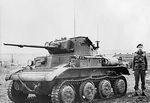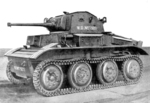Light Tank Mk VII Tetrarch
| Country | United Kingdom |
| Manufacturer | Metro-Cammell Carriage & Wagon Co., England, UK |
| Primary Role | Light Tank |
Contributor: Alan Chanter
ww2dbaseAfter collaborating on the design of the series of British light tanks of the 1930s, Vickers-Armstrong Limited decided that they had some better ideas and in 1937 set about developing a "private venture" light tank. The prototype completed at the end of 1937 was known as the Light tank Mark VII or Tetrarch was offered to the War Office in 1938 and accepted.
ww2dbaseThe 7-ton Tetrarch was a very clean design, using a four wheeled Christie-type suspension with an interesting modification based on the track-warping steering device of the Vickers Carriers in which the four road wheels on both sides could be turned into a curve for steering in a wide radius. For very tight turns a linkage engaged the track brake to add to the turning force. The turret mounted a 40mm 2-pdr gun, and the vehicle was very fast and agile.
ww2dbaseAlthough armoured only up to 16mm, the Tetrarch had a similar main armament as a contemporary British cruiser tank - a 2-pdr gun with coaxial 7.92-mm Besa machine gun. The Little John adaptor, to greatly increase the muzzle velocity of the 2-pdr, was later fitted to some tanks, although the conversion had a tendency to wear out the gun's barrels at an uncomfortable rate.
ww2dbaseUnfortunately, just as the first production tanks, known at the time as the Purdah, were beginning to appear from the Metropolitan-Cammell Carriage and Wagon Company Limited (a Vickers-Armstrong subsidiary) in the summer of 1940, the Army was having second thoughts about light tanks. The campaign in France had shown that they were no longer viable units on the battlefield, and the General Staff was turning to the use of armoured cars for reconnaissance. Production was halted while the problem was discussed and just at that time a new factor appeared on the scene, the idea of airborne troops. The Tetrarch was light and compact and it was hoped that it would prove to be a viable air-portable tank. Production was restarted in 1941 and a total of 171 Tetrarch tanks were built (although production was seriously interrupted by damage caused by an air raid on the factory) with the last being delivered during 1942.
ww2dbaseIt was received by the army without much enthusiasm as it had no outstanding attributes, being considered by many to be too poorly armed and armoured and lacking a specified purpose. Nevertheless in 1942 some Tetrarch tanks, formed into a half squadron, participated in the British invasion of Madagascar. A small number were passed to the Soviet Union where they were greeted with a similar lack of enthusiasm, but the bulk of the stocks were reserved for use in airborne operations.
ww2dbaseThe Tetrarch created history on the eve of the French invasion in 1944 when about half a dozen tanks were flown in Hamilcar transport gliders to Normandy. Fitted with a 3-inch howitzer these tanks were intended to provide close support for the paratroopers of 6th Airborne Division during the battle to establish a bridgehead in France. On 7 Jun 1944, the German 21st Panzer Division attacked the Allied bridgehead with ninety tanks but by then the British 3rd Division, once Montgomery's pride, was ready for them. The anti-tank guns opened up at 2,000 yards and eleven Panzers were left burning. The remaining German tanks swung westward to find a gap and some even managed to reach the sea at Luc-Sur-Mer, but the sudden arrival of the Air Landing Brigade with their Tetrarch tanks prevented the Germans from further exploiting their attack. Apart from this one episode the little Tetrarchs proved no match for enemy armour and their role was later assumed by the American M22 Locust.
ww2dbaseAfter the war a small number of Tetrarchs (and their larger sibling, the Light Tank Mk VIII Harry Hopkins) remained in service with the British Army for a short while whilst work continued on the FV300 air-transportable tank project (itself cancelled in 1950 when all remaining Tetrarch tanks, much to the relief of armoured soldiers, were finally retired).
ww2dbaseSources:
Ian V. Hogg & John Weeks, The Illustrated Encyclopedia of Military Vehicles (Hamlyn, 1980)
B. T. White, Tanks and other Armoured Fighting Vehicles 1942-45 (Blandford Press, 1975)
A. J. Smithers, Rude Mechanicals (Grafton Books, 1989)
Philip Trewbitt, Armoured Fighting Vehicles (Dempsey Parr, 1999)
British Tanks 1946-1970 (RAC Tank Museum, 1973)
Last Major Revision: Feb 2012
SPECIFICATIONS
Tetrarch
| Machinery | Meadows horizontally-opposed 12-cyl petrol engine rated at 165bhp at 2700rpm |
| Suspension | Coil spring |
| Armament | 1x40mm 2pdr gun (50 rounds) or 1x3in howitzer, 1x7.92mm coaxial Besa machine gun |
| Armor | 4-16mm |
| Crew | 3 |
| Length | 4.11 m |
| Width | 2.31 m |
| Height | 2.10 m |
| Weight | 7.6 t |
| Speed | 45 km/h off-road; 65 km/h on-road |
| Range | 225 km |
Photographs
 |  |  |
Please consider supporting us on Patreon. Even $1 per month will go a long way! Thank you. Please help us spread the word: Stay updated with WW2DB: |
- » US Government Plans to Purge WW2 Information (17 Mar 2025)
- » WW2DB's 20th Anniversary (29 Dec 2024)
- » Wreck of USS Edsall Found (14 Nov 2024)
- » See all news
 |
- » 1,166 biographies
- » 337 events
- » 44,601 timeline entries
- » 1,243 ships
- » 350 aircraft models
- » 207 vehicle models
- » 376 weapon models
- » 123 historical documents
- » 261 facilities
- » 470 book reviews
- » 28,551 photos
- » 375 maps
Fleet Admiral Chester W. Nimitz, 16 Mar 1945
Please consider supporting us on Patreon. Even $1 a month will go a long way. Thank you!
Or, please support us by purchasing some WW2DB merchandise at TeeSpring, Thank you!